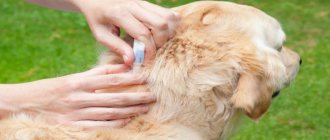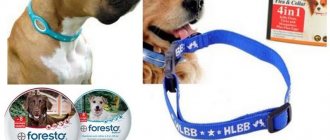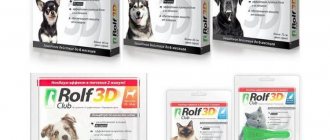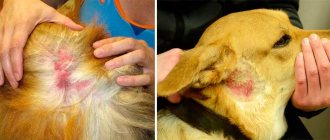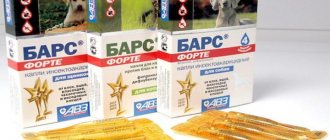During the cold season and also in spring, the problem of combating external parasites among our four-legged friends becomes more urgent than ever. The most dangerous of which for dogs are ixodid ticks, most of which carry Babesia in their saliva, which causes one of the most famous diseases among dog breeders in our pets - babesiosis or piroplasmosis.
Like many other parasitic diseases, babesiosis is more effective in prevention than in treatment. There will be a separate article on our website about what drugs are used to treat this disease. So, let's figure out what methods of protection exist against ticks.
External protection methods
External protection against ticks is the most common way to combat parasites. This includes: wearing animal clothes, examining and combing after walks, applying drops to the withers, wearing insectoacaricidal collars, and using shampoos. Methods of external protection primarily include drops on the withers against ticks for dogs.
In many preparations for the withers, the main active ingredient is a strong insecticide with a wide spectrum of action, namely fipronil. And seeing this component in the first place in the composition of drops for the withers, many people wonder: what exactly is the difference between drops from different manufacturers, because the price for them is sometimes very different?
The whole point is that the principle of action of the drug is based on the absorption of fipronil into the body through the skin of the animal. For better availability of drugs and absorption in the body, excipients are added to fipronil, the composition of which determines the price of the drops.
It is also necessary to note that all drops on the withers are fat-soluble, so if you bathe your animal with shampoo a few days before or after treatment with drops against ticks and fleas, you will not get the desired result, or rather you will not get it at all, and the animal will remain without protection against external parasites.
Therefore, drops on the withers against ticks for dogs are not suitable for those animals that, for some reason, do not have a lipid layer on the skin. Also, drops are not suitable for emergency protection against fleas and ticks, since they need several days to be absorbed into the body.
Kennel club "Vernost"
How to use tick repellents correctly
TICK AND FLEA TREATMENT
How dangerous are ectoparasites? In massive quantities they cause exhaustion and death of the animal. But even a single bite can cause great harm, as they are carriers of various diseases.
Ixodid ticks carry piroplasmosis (babesiosis) and tick-borne borreliosis (Lyme disease). Fleas are a source of infection with tapeworms (dipylidiasis). Mosquitoes can transmit leishmaniasis and dirofilariasis (heartworms).
Getting rid of fleas is not difficult - treatment with modern drugs protects against infection for up to six months. Mosquitoes are a big problem, but, fortunately, diseases transmitted by them are quite rare in the middle zone. The likelihood of infection is higher in the southern regions of Russia. Therefore, when going on vacation with your dog, check the epidemiological situation and treat the dog with appropriate medications in advance. Ticks are the main enemy and headache of all dog owners.
Ixodid ticks are ubiquitous and are infested with piroplasma on a massive scale. There are no remedies for them that provide a 100% guarantee of reliability! The problem is that highly toxic compounds that cause guaranteed death of the tick also harm the dog itself. In addition, some substances have the ability to gradually accumulate in the body. And you have to protect yourself from ticks for at least 6 months a year! When choosing a drug, you have to balance between reliability and toxicity. Therefore, be sure to look at what active substance is used. If the manufacturer does not indicate the composition, do not buy! Read the manufacturer's instructions carefully, and do not take advice from friends on walks!
What to choose - drops on the withers, spray or collar?
It all depends on the specific situation. With a high concentration of ticks, for greater reliability, you can combine drops and spray, or spray and collar. The main thing is that the active substance in them is from different groups in order to avoid an overdose. Sprays begin to act immediately after treatment. Drops on the withers should be absorbed into the skin and distributed over it, this usually takes at least a day.
FRONTLINE SPOT ON drops (Merial, France) – active ingredient fipronil
FRONTLINE spray (Merial, France) – active ingredient fipronil
PRAC-TIK drops (Novartis Animal Health, Germany) – active ingredient pyriprole
ADVANTIX drops (Bayer, Germany) – active ingredients imidacloprid and permethrin
BOLFO spray (Bayer, Germany) – active ingredient propoxur
HARTZ drops (HARTZ, USA) – active ingredient phenothrin
BLOKHNET drops (Astrapharm, Russia) – active ingredients fipronil, benzyl benzoate, dimethyl phthalate
BLOKHNET spray (Astrapharm, Russia) – active ingredients fipronil, benzyl benzoate, diethyltoluamide, juvemon
BARS drops (Agrovetzashchita, Russia) – active ingredient fipronil
BARS spray (Agrovetzaschita, Russia) – active ingredient fipronil
DANA drops (Api-San, Russia) – active ingredient diazinon
DANA spray (Api-San, Russia) – active ingredient permethrin
ROLF CLUB drops (NPF “Ekoprom”, Russia) – active ingredients fipronil, pyriproxyfen
ROLF CLUB spray (NPF “Ekoprom”, Russia) – active ingredients fipronil, pyriproxyfen
CLEANITY drops (NPF “Ekoprom”, Russia) – active ingredients fipronil, permethrin
CLEANITY spray (NPF “Ekoprom”, Russia) – active ingredient permethrin
VECTRA 3D drops (Ceva Sante Animale, France) – active ingredients dinotefuran, permethrin, pyriproxyfen
For puppies, pregnant and lactating bitches, FRONTLINE SPOT ON drops are usually used on the withers, as they are slightly toxic to mammals. I treat it once every four weeks if the dogs don’t bathe, or every three weeks if they do. I treat adult dogs that have no contraindications with BLOCHNET drops every four weeks. Additionally, I spray with DANA spray before each “dangerous” walk - in the forest, in the fields. And, of course, after every walk I carefully examine the dogs, since fipronil does not repel ticks - they crawl out of the fur, wander through it, but do not bite. Permethrin repels well, but treating a Labrador completely, “without holes,” and even once every two weeks, is hard work. In addition, permethrin is washed off with water. A morning walk in the dew, an afternoon swim in the lake... and I no longer know how protected my dogs are. Therefore, I only use it in combination with drops. The combination of two active ingredients - fipronil and permethrin, gives, from my point of view, the best result.
Collars contain long-lasting insoluble compounds that gradually transfer to the fur. They begin to act after a few days, when the substance is distributed. The collar must be worn constantly without taking it off.
KILTIX (Bayer, Germany) – active ingredients propaxur and flumethrin SCALIBOR (MSD Animal Health/Intervet LLC, Russia) – active ingredient deltamethrin BEAFAR (Beaphar, Holland) – active ingredient diazinon
BOLFO (Bayer, Germany) – active ingredient propaxur
I don't use collars for the following reasons. First, I don’t have one dog, but several. In games, they chew and lick each other, grab collars with their teeth - there is a high probability of poisoning. (In families where there are small children, it is also impossible to keep track of whether they touched the collar or washed their hands after that...) The second reason is that directly under the collar the concentration of the toxic substance is especially high, which causes skin problems. Of course, this is very individual and depends on the dog’s sensitivity, but it is not uncommon. The third reason is that collars smell strongly.
The first (spring) treatment against ticks should be carried out as soon as the “plus” night temperature has established.
The dog should not be washed three days before and two days after treatment.
Mark each treatment on your calendar so you don't miss the next one.
If you combine products (drops + spray), treat with the second product no earlier than 10 days after the first.
After each walk, inspect your dog and destroy any ticks found.
If the dog is dark and ticks are difficult to see, comb the fur with a fine comb.
If, despite the measures taken, the dog is bitten by a tick, carefully monitor its well-being for three weeks. At the first signs of lethargy, refusal to eat, you need to measure your rectal temperature, and if it is elevated (the norm is 38.4 - 39.0), go to the vet immediately. clinic and do a test for the presence of Babesia in the blood. With timely treatment, piroplasmosis is curable, but every hour of delay reduces the chances of a successful outcome!
Spring-summer-autumn, time for mandatory treatment of dogs against ticks!
Why are treatments not always effective?
When there are cases of piroplasmosis in my kennel, I always ask the owners in detail how and with what the dogs were treated. An interesting pattern emerges - almost always either the deadlines or the rules for using drugs were violated. Therefore, I would like to remind you once again how to properly treat your dog against ticks with drops.
1) 3 days before treatment, the dog should not be washed, not bathed, but rather washed with detergents. Why? Because the fatty layer, in which the protective agent should actually be distributed, is washed off
2) You cannot bathe for 2 days after treatment. Why? Because the protective agent must be distributed throughout the fatty layer covering the dog’s fur, and this takes time.
3) Drops should be applied to the skin (not to the fur), pointwise! Do not pour the entire pipette in one place, but distribute it drop by drop along the back, starting from the back of the dog’s head to the middle of the lower back.
4) Drops must be stored correctly - in a dark place, at a temperature from 0 to 35 degrees. Therefore, it is very important to buy drugs in trusted places where storage conditions are met and where there is no chance of purchasing a counterfeit.
5) Write down processing times! You cannot rely on memory; even one missed day can be fatal. Frontline Spot drops last for 3 weeks if the dog bathes regularly or 4 weeks if the dog does not bathe. Follow these deadlines!
6) After each walk, inspect the dog and remove crawling ticks from it. Drops of ticks do not repel ticks, they seem to “make the dog not tasty.” Therefore, there is time to collect them and destroy them.
How to protect your dog from ticks
Almost all owners have heard that ticks are dangerous for dogs. Not everyone knows what the dangers are, what they cause and how to properly protect your dog from ticks. Here are some misconceptions of owners that we encounter in the process of work:
-that ticks cause encephalitis in dogs, -that it is enough to put drops on the withers once at the beginning of spring and the dog will be protected for the entire period, -that a tick can only be “caught” in the forest, and since we don’t go into the forest, then There is no need to treat the dog - if you find a tick on the dog, you need to urgently administer serum like in humans or start treatment.
In this article we will try to sort everything out.
Tick season begins with spring warming and snow melting. For humans, ticks are carriers of the causative agent of viral encephalitis (a disease of the central nervous system), borreliosis, and in dogs quite often a blood parasitic disease occurs - piroplasmosis (blood cells - red blood cells are affected) or, somewhat less frequently, borreliosis (otherwise known as Lyme disease). The peak activity of ticks occurs in spring and autumn, so it is necessary to carry out treatments from early spring to late autumn. Simply applying drops to the withers at the beginning of spring is not enough; it is necessary to carry out treatments regularly, the interval depends on the type of drops. We will write about the pros and cons of anti-tick medications below, but now we will tell you about the measures that need to be taken if your dog has already been bitten by a tick:
1. After each walk, the dog must be examined and felt with your fingers, especially with thick hair, and especially carefully the head, neck, chest and groin in order to detect and remove the tick as early as possible. Ticks attack dogs not only in the forest or park, as some dog breeders mistakenly believe, but also in courtyards and squares.
2. If a tick is found, it must be removed. It is better to do this at the veterinary clinic. The place where the female tick’s head meets the abdomen is very tender and easily tears, so you can’t pull the tick by the abdomen, you can simply tear it off, the head and legs will remain in the skin, it is very difficult to remove them and, as a rule, a local inflammatory process begins. You need to remove the tick with a special device (can be bought at a veterinary pharmacy) or tweezers using a twisting motion. To protect yourself, wear gloves because... It is not known what kind of “filling” this tick has – whether it is dangerous for a dog or a person. After removal, the wound must be treated with an antiseptic, for example, iodine. Ticks do not sink in water and are practically impossible to dry out. You should not try to crush them - this may lead to the spread of the infection they carry. The best way to kill a tick is to burn it.
3. The moment of infection with piroplasmosis does not occur immediately at the moment of the bite, as they write in some articles on the Internet, but only on the second day, when the female drinks blood and squeezes back the liquid (unnecessary) part of the blood, then the piroplasm from the salivary glands of the tick under pressure (like a syringe) and enter the dog’s blood. Therefore, it is unlikely that a newly attached tick with an unfilled abdomen will cause disease.
4. Next, you need to very carefully monitor the dog’s condition and measure body temperature rectally every day. The fact is that not all ticks are carriers of piroplasmosis; a “healthy” tick can also attack a dog. And, as a rule, before clinical signs of the disease appear, piroplasms are not detected in the blood. The first signs for which you should immediately consult a doctor are: an increase in body temperature above 39.5 degrees, lethargy, refusal to eat, the mucous membranes of the eyes and mouth are pale or yellowish, urine with blood or a dark color, weakness of the hind limbs, may have diarrhea. The destruction of red blood cells occurs in the body, which affects all organs, primarily the heart, liver, kidneys, spleen, and pancreas. Owners make a big mistake when, seeing such manifestations, they do not go to the clinic, but carry out symptomatic treatment at home in the form of antipyretics, treats to increase appetite, etc.
If you removed the tick yourself, then if at least one of the listed signs appears (for example, only lethargy), take your pet to the clinic. Recently, piroplasmosis often manifests itself atypically, or blurred in a chronic form. It happens that you have to take blood tests several times to find parasites. The period from infection to the onset of clinical signs can be from 2 to 20 days.
5. A very important point is urgent, or timely contact with a doctor for diagnosis and treatment. The earlier the disease is detected and treatment is started, the greater the likelihood of the pet’s recovery, in a short time (for example, 3 days) and for less money. There are often cases when owners do not understand the danger of the disease, wait several days and come to the appointment when it is already difficult for doctors to save the dog.
6. An accurate diagnosis can only be made using a blood smear from peripheral small vessels. As a rule, a drop of blood is taken on glass from the ear, rarely from the claw. In our clinic, the analysis is ready immediately at the appointment in 15-20 minutes. In the photo - there are 2 pear-shaped purple formations in the erythrocyte - these are piroplasms.
7. Treatment consists of the administration of an antiparasitic drug and a course of drips that relieve intoxication and help the body recover. There is no serum with antibodies, as in the case of human tick-borne encephalitis. The antiparasitic drug is very toxic, so it is administered only after a diagnosis has been established, and is calculated strictly based on the dog’s weight. A course of treatment, depending on the weight of the dog, costs from 3 to 7 thousand rubles.
8. Chronic course. In a chronic course, all of the listed symptoms are blurred. And it is not always possible to immediately determine the cause of the disease. After contracting piroplasmosis, 80% of dogs are carriers of piroplasma (depot in the spleen); there are no clinical signs. Stable immunity against piroplasms is not developed, so the animal can get sick again and again. There are cases where, for example, a dog suffered from piroplasmosis for two years in a row and received treatment; in the third year the disease was again confirmed in the laboratory, but the owners refused treatment; the dog, fortunately, recovered. But this is the exception rather than the rule.
9. Prevention.
For prevention, the veterinary drug market offers: drops on the withers, sprays, collars, and since 2009, the Pirodog vaccine (Merial company, France) has appeared in our country. The effects of external preparations differ in: repellent (repellent sprays), contact (ticks die upon contact with treated hair and skin) and protection against infection with piroplasmosis, but do not protect against tick attacks.
1) Drops on the withers
(spot-on). Drops on the withers against ticks and fleas are now on sale in a large selection. There are imported and domestic ones, they have different active ingredients, different periods of protection against ticks and fleas, the price ranges from 25 to 700 rubles. The most important condition is to carry out the treatments correctly and in a timely manner, i.e. if the packaging says that the drops protect against ticks for 4 weeks, then you need to observe an interval of 4 weeks, and not 4.5 or 5 or more, because even a few days that the dog remains unprotected can lead to piroplasmosis. Another important point is to buy pipettes strictly according to the dog’s weight, apply directly to the skin, and do not bathe the dog 3 days before and after treatment. Always carefully read the instructions for anti-tick medications - what weight the pipette is designed for, how long protection is guaranteed, at what age and weight of a puppy or dog the drug can be used, and whether it is suitable for pregnant and lactating bitches (!).
The drops are convenient and easy to use, and can be easily selected for a dog’s specific weight.
– Frontline spot-on (France) – the manufacturer guarantees protection against ticks of 95% and against fleas of 100%, subject to all treatment conditions, does not have a repellent effect, so there is no need to be afraid that ticks can attack the dog, it protects against infection with piroplasmosis . When a female tick drinks blood containing the active substance fipronil, she dies without having time to squeeze back the liquid part of the blood and release piroplasm into the dog’s blood. Fipronil is absolutely safe for dogs, does not cause allergies, and is non-toxic. Frontline can be used on pregnant and lactating bitches, as well as puppies from 2 months of age and starting with a puppy/dog weight of 2 kg (up to 2 months, even from birth, and up to 2 kg Frontline spray is suitable). The manufacturing company Merial was the first in the world to use purified fipronil, has conducted and continues to conduct a lot of research on its products and values its reputation.
– Rolf-club, Praktik (Germany), Mr. Bruno, Fiprex – generic drugs created on the basis of fipronil after the discovery of Frontline, manufacturers did not need to conduct research and confirmation, because they followed the beaten path and the effectiveness of such drugs was declared to be 80% .
– Hartz (USA), Advantix, Dana (Russia), Celandine (Russia) – preparations based on permethrins or organophosphorus compounds – have a contact effect, i.e. The tick dies upon contact with the animal's fur. Disadvantage - they are easily washed off with water (dew, rain, puddles, ponds), not suitable for pregnant and lactating dogs, sick and weakened dogs, as well as puppies under 6-8 weeks of age. It is better to use such drops more often than what is written on the package. – Stronghold, Advocate, Advantage drops DO NOT PROTECT against ticks
2) Sprays.
Sprays are also based on different substances: fipronil (Frontline) and pyrethroids (Dana, Celandine, Bolfo-spray).
– Frontline spray is convenient to use for puppies under 2 months of age and weighing less than 2 kg, for smooth-haired small dogs, for hairless dogs, and also as additional protection to Frontline spot-on drops for treating open areas of the body (ears, jowls) , belly, between the toes) for dogs that like to bathe frequently or, for example, hunting dogs. In this case, there will be no overdose of fipronil, guaranteed by the manufacturer. The meaning of protection is the same as that of Frontline spot-on drops. It is not recommended for use in large (too high consumption), thick-haired dogs (difficult to reach the skin), because the animal should be wet from the drug when properly treated.
– Sprays based on pyrethroids – must be applied 1-2 times a week (see instructions), sprayed against the growth of fur, avoiding contact with eyes, mouth, nose, this must be done outdoors (since inhaled vapors are toxic!), cannot be used puppies under 6 weeks of age, pregnant, lactating, sick, weakened animals, avoid licking the drug after treatment by the animal itself or other animals.
When owners have complaints that “the drug is not working,” this can mean two things:
a) the owner and his animal are included in the remaining 100 percent guaranteed by the drug manufacturers (for example, the manufacturer’s guarantee is 80%, then you are included in the remaining 20), subject to compliance with all rules and processing times.
b) the owner carries out the treatments incorrectly - the first treatment is carried out not at the beginning of spring, but later, the interval between treatments is not observed, one pipette is dripped onto several animals in order to save money, the dog is bathed, it swims in natural springs or gets exposed to rain for 3 days before or after treatment with drops or sprays, or taken out for a walk immediately after applying the drops. For example, abroad all vaccinations, treatments against worms, as well as treatments against fleas and ticks are carried out only by a veterinarian, and “incorrect” or untimely treatments are simply excluded.
3) Collars. The collars are impregnated with drugs that create a protective cloud around the dog (repellent effect), and also spread through the coat and sebaceous glands, providing contact protection. The service life of the collar is 5-7 months, it must be worn without taking it off so that there is constant contact with the fur and skin, and not as an accessory for a walk. Although many collars say that they are waterproof, if your dog bathes frequently, it is better to change the collar before the specified time. It should not be used by pregnant, lactating, sick or weakened animals, puppies under 2 months of age, and some, for example, Beafar, can only be used from 6 months of age. May cause local irritation upon contact with skin in the neck area.
Some owners play it safe and use both drops and a collar for protection. It is better not to do this, because when mixing two drugs from different groups, something third is obtained on the skin, it is unknown how it affects the animal’s body, and it is quite capable of causing an allergic reaction or intoxication.
4) The Pirodog vaccine (Merial, France) was developed to create immunity in dogs against piroplasmosis, the vaccine effectiveness is 76-80%. Vaccination must begin at 5 months of age, when the puppy has already been vaccinated against viral infections. The vaccination is given twice with an interval of 3-4 weeks, revaccination after a year, if the dog is often attacked by ticks - then once every six months. If the dog is a carrier of piroplasma (previously had the disease), then the vaccine can provoke the disease, i.e. manifestation of clinical signs (in this case, standard treatment + treatment with drops is necessary). Pregnant dogs cannot be vaccinated; vaccination cannot be combined with other vaccines (with the exception of vaccines against leptospirosis and rabies).
Many experienced dog breeders have already made their choice in favor of one or another method of protecting their pet from ticks and piroplasmosis. We hope that this article will help novice dog owners make their choice, and will also clarify the existing ideas and beliefs of dog breeders about anti-tick treatments.
Inchina Anna Aleksandrovna, veterinarian at the MEGAvet clinic
How to protect your dog or cat from tick bites? What to do if a tick bites your pet?
Tick-borne encephalitis and tick-borne borreliosis are not dangerous for dogs and cats; they do not suffer from these diseases. For them, ticks are primarily dangerous due to the infectious disease piroplasmosis.
Piroplasmosis is a serious infectious disease of dogs and cats, which, unfortunately, is quite widespread. The causative agent of piroplasmosis is single-celled microorganisms of the species Piroplasma canis, which parasitize blood cells - erythrocytes. The main way of transmitting this disease between animals is through a tick bite. Most piroplasmosis diseases occur during the active season of ticks, that is, in spring and autumn.
First of all, remember to protect your pet from tick attacks.
Today there is a large selection of different products in the form of sprays, collars and drops on the withers. How do these drugs work, and which one should you choose to protect your pet? And the form of release of the drug, and the quality of the product, and the authority of the company that produces it, matter.
The composition of any form of a protective drug includes an active substance and a filler in which this active substance is dissolved. Drops differ from sprays in the concentration of the active substance per unit volume, and with insectoacaricidal collars both the active substance and the solvent are applied to a special synthetic base in the form of a tape (collar).
Upon contact with the skin after applying drops, sprays or while wearing a collar, due to the lipophilic properties of the filler (the ability to easily dissolve in fats), the insectoacaricide is absorbed into the subcutaneous tissue and accumulates in the sebaceous follicles. From there, along with the secretion, the insectoacaricide is released onto the surface of the skin in small portions for a long time. Therefore, treated animals can be bathed within two to three days.
It should be borne in mind that ticks and other insects can attach to the animal’s fur, but immediately after this the active substances of the protective agent begin to act on them. This leads to a sharp decrease in tick activity, and then to death. The manufacturer's recommended application regimens for most products are as follows: the drug must be applied to the animal's skin in some way - drops and sprays are distributed at several points once every two to four weeks, and the active substance from the collars is gradually absorbed into the skin while it is worn.
However, with this method of application, the highest concentration of the protective substance is created in the immediate vicinity of the animal’s skin, and very unevenly. This is quite enough to protect against fleas, lice and lice. But for more “tenacious” ixodid ticks, additional protection is required in the form of daily application of a spray to the animal’s fur. This is especially true for long-haired dogs and cats.
Based on this, the most effective means of protection are insectoacaricidal sprays, used according to the following scheme: basic treatment by applying a spray to the skin once every few weeks, in the amount recommended by the manufacturer, plus daily spraying of a small amount on the animal’s fur.
For example, “Frontline” spray, 250 ml French or its analogue “Fipron” spray, 250 ml Czech is recommended to be used as follows: once every three to four weeks, at the rate of four presses of the distribution head per kilogram of live weight of the animal, sprayed onto the skin animal - as a basic treatment (the spray distribution head has two positions - for jet application and spraying), plus daily spraying on the fur (two to six presses of the distribution head are enough).
A combination of drops on the withers (as a basic treatment) and sprays (for daily treatment) containing the same active ingredient is acceptable. You can use this method, for example, the drug "Frontline", which is available in the form of drops on the withers and in the form of a spray. The combination of insectoacaricidal collars, drops on the withers and sprays from various companies cannot be considered rational for the following reasons. Firstly, when two or more protective substances interact on the surface of an animal’s skin, a third, less effective or even toxic substance can be obtained, and secondly, the likelihood that your pet will develop an allergic reaction sharply increases. It is important not only how effectively the drug acts on parasites, but also whether it has side effects (high toxicity, allergenicity). Therefore, it is better to choose high-quality, proven drugs.
There are no other preventive means of preventing infection with piroplasmosis: to date, neither a vaccine nor serum (immunoglobulin) against this disease has been invented. It’s worth mentioning right away that the listed insectoacarizid agents, even with daily use, do not protect one hundred percent from tick attacks, so an additional examination of the animal after a walk will not hurt.
What to do if, despite all the measures taken, the dog is still bitten by a tick?
First, remove and burn the parasite.
You should not remove a tick with your bare hands (use tweezers, gloves, etc. - the main thing is to avoid contact with the tick on your skin and mucous membranes - there is a danger of contracting other diseases that are already dangerous to humans.
It is convenient to remove ticks with curved tweezers or a surgical clamp; in principle, any other tweezers will do. In this case, the tick must be grabbed as close to the proboscis as possible, then it is carefully pulled up, while rotating around its axis in a convenient direction. Usually, after 1-3 turns, the entire tick is removed along with the proboscis. If you try to pull the tick out, there is a high probability of it breaking.
There are special devices for removing ticks.
These devices have an advantage over clamps or tweezers, since the body of the tick is not compressed, squeezing the contents of the tick into the wound is avoided - reduces the risk of contracting tick-borne infections.
The Uniclean Tick Twister has proven itself well - this device for removing ticks can be purchased in Russia.
If you are unable to remove the tick yourself, contact a veterinarian.
Secondly, pay attention to the general condition and behavior of your pet: lethargy, refusal to feed, increased body temperature to 39.5-410 C, change in the color of urine - any of these symptoms is a reason to contact the clinic.
But if you receive an offer to give your dog a “tick injection” (this is the usual wording of both dog owners and “persons of para-veterinary passion”), then think carefully before accepting this help. Human viral encephalitis immunoglobulin is in no way suitable for the prevention or treatment of piroplasmosis. In addition, the use of this drug, which is very non-specific for animals, not only will not bring any benefit, but can also seriously allerge the dog’s body (and cause significant damage to your wallet through pointless spending).
There is also no need to rush into administering a specific antipyroplasmid drug, such as veriben or azidine. On the one hand, these drugs are extremely toxic (in fact, they are poisons), on the other hand, their effect does not last long. Therefore, if the tick that has bitten an animal turns out to be uninfected (and on average 3 to 14 percent of insects are infected with piroplasmas), then with the so-called preventive therapy you will deal a heavy blow to the entire body, to the liver and immune system in the first place.
If the worst happens, and a couple of days after the tick bite you notice something wrong in the dog’s behavior, immediately go to the clinic. Piroplasmosis is a rapidly developing disease: only a few days can pass from the appearance of the first clinical signs (often unspecific) to severe toxic damage to the body (or even death).
At the veterinary clinic, in addition to conducting a clinical examination, your pet must be tested for piroplasmosis. A drop of blood for a smear is taken from the dog’s ear (not from a vein!) - it is in the peripheral vessels that the largest amount of piroplasms is deposited. The diagnosis of piroplasmosis is considered established only after its laboratory confirmation. If laboratory diagnostics are not carried out, then even if the classic triad of symptoms characteristic of piroplasmosis appears: hyperthermia (high temperature), hematuria (“bloody urine”) and ectericity (jaundice) - no doctor is immune from fatal errors.
Therapy for piroplasmosis should not be limited to only a course of a specific anti-pyroplasmosis drug. Such limited treatment is fraught with the development of a host of chronic diseases in the future. Moreover, a dog can become infected more than once: immunity is not formed after an illness.
As already noted, with piroplasmosis, the kidneys, liver and hematopoietic system are primarily affected, on which the state of immunity largely depends. And if kidney-hepatic problems are usually not forgotten, then not all veterinary specialists remember about the total immunodeficiency that accompanies piroplasmosis, which arises as a result of the combined toxic effect of piroplasms and poisons introduced to destroy these same piroplasms.
Moreover, in this case, not every immunostimulant is suitable for correction. First of all, it should be a drug that stimulates hematopoiesis (i.e., the production of new red and white blood cells in the blood depots) in the most effective way and, at the same time, activates existing cells of the immune system.
The most modern product that meets these requirements is RONKOLEUKIN® (IL-2), produced (St. Petersburg). The use of this immunomodulatory drug in the complex therapy of piroplasmosis will not only facilitate the fight against the disease itself, but will also help to avoid unwanted complications after treatment.
Tools and accessories for tick removal
It is convenient to remove ticks with curved tweezers or a surgical clamp; in principle, any other tweezers will do. In this case, the tick needs to be grabbed as close to the proboscis as possible, then it is gently pulled and at the same time rotated around its axis in a convenient direction. Usually, after 1-3 turns, the entire tick is removed along with the proboscis. If you try to pull the tick out, there is a high probability of it breaking.
Currently, industry, including Russian industry, has launched the production of special devices for removing ticks from both people and animals. Most often this is a hook similar to a curved two-pronged fork. The plier is inserted between the teeth and then unscrewed.
These devices have an advantage over clamps or tweezers, since the body of the tick is not compressed and the risk of contracting tick-borne infections is somewhat reduced.
Tick Twister (TICK TWISTER) - a hook for removing ticks. Externally, the device looks like a small nail puller. The kit includes two hooks for removing large and small ticks. The tick is grabbed from the side, slightly pulled and twisted.
Popular and effective drops on the withers
Drops Bars
The most famous anti-flea and tick drops today are from the domestic company AVZ. The undeniable advantage of this product is its price. Although the drugs from this manufacturer are one of the very first drops against fleas and ticks in our country, the company is expanding its line with new forms of this drug.
So, in addition to the classic “one pipette per 10 kg” for dogs and cats, there are now dosed pipettes for each weight range: 2-10 kg, 10-20, etc. Also, not so long ago, Bars Forte appeared, which has a repellent effect. By repelling blood-sucking insects, it prevents dirofilariasis in dogs.
Disputes about the effectiveness of this line of flea and tick products continue constantly and will most likely remain relevant as long as Bars remains one of the cheapest types of tick drops for dogs.
Frontline combo
Effective drops on the withers against ticks for dogs. A big advantage of this type of drops is the possibility of use in pregnant and lactating pets. The price is rather above average, but it is justified by the quality composition. Frontline was awarded the World Branding Awards as “Brand of the Year 2019-2020”.
Stronghold
The principle of action of the drug is based on selamectin, which is part of its composition, which acts not only on external parasites such as fleas, scabies and ear mites, lice mites. Also, drops on the withers against ticks for dogs Stronghold are effective against internal dangerous parasites, such as heartworms and roundworms.
Tick collars
Collars are similar in their principle of action to drops on the withers, but are a safer method of protection against ticks and fleas, since they are absorbed by the body gradually, according to the degree of abrasion of the active layer on the collar.
In other words, the principle of operation of a tick collar is friction between the skin and the collar itself, and it is important that the collar is tightly tightened and does not hang around your four-legged friend’s neck, otherwise you will not achieve the desired result.
View in the online pet store petshop.ru
Effective Collar Brands
Bars tick collar . In addition to inexpensive drops for the withers, the AVZ company also produces collars for dogs of three types - sizes: small, medium and large dog breeds, again to save money for owners of small breed dogs. The effect is definitely worth the money. Wearing an inexpensive collar is better than not treating your pets at all.
Tick collar Inspector. An effective method of combating not only ixodid ticks, but also ear mites, lice eaters, fleas, as well as nematodes of the gastrointestinal tract. The price is closer to average, which cannot but please dog owners. There are several types and sizes. Provides 4 months of flea protection, 3 months of tick protection and 2 months of helminth protection.
Foresto tick collar . Provides reliable protection against fleas and ticks for up to 8 months. The unique matrix of this collar allows you to maintain a minimum dosage of the substance entering the body, which makes the collar very safe for the health of your beloved pet. In addition, due to the uniform distribution of substances throughout the coat, ticks should die from contact with the dog without biting it. Of course, Foresto is much more expensive than other effective brands of collars, but it is a very effective way to fight against ticks and fleas.
View in the online pet store petshop.ru
The danger of fleas for dogs
Fleas are one of the most common blood-sucking parasites on Earth, with more than 2,300 species. But such diversity should not worry dog owners, because the methods of dealing with all types of these insects that have lost their wings during evolution are the same.
It is generally accepted that fleas are completely harmless and do not pose a threat to the health of the animal, but this is not at all true. The insect bites through the dog's skin and injects saliva into the wound, simultaneously rewarding the victim with thousands of bacteria. Among them are those that can cause dermatitis, acute allergic reactions and dangerous infectious diseases.
Fleas are also carriers of helminth eggs, that is, worms. And, of course, needless to say that a dog affected by insects experiences serious suffering from the itching that accompanies the bites. She literally does not know a minute of peace, constantly itches and bites her teeth into the skin, trying to get rid of annoying guests.
Fleas that infect dogs can also be dangerous to humans. Although they won’t live on it - it’s not comfortable, there’s no fur - but they bite with great pleasure and with all the ensuing consequences. Since flea eggs do not attach to the skin in any way, they can be found everywhere where your pet sat or lay. After some time, the eggs will hatch into larvae, which will then pupate, and the adult flea will leave the cocoon as soon as it senses that there is “food” nearby - that is, any warm-blooded creature.
It’s quite easy to see insects on your dog: adult individuals can be seen with the naked eye if you run your hand against your pet’s fur; the eggs look like grains of salt, and waste products look like dark peppercorns.
It is impossible to select all the fleas by hand - the female lays 30–50 eggs per day. Therefore, in order to rid your dog of parasites, you need to resort to special insectoacaricidal products for dogs against fleas and ticks, preferably complex ones, which will also protect your pets from helminths. We will tell you exactly which one a little later, after we introduce you to an even more dangerous enemy of dogs.
Anti-tick sprays for dogs
Sprays are suitable for those people who need to get results “here and now”, because this is the fastest way to protect against ticks and fleas. Ease of use and the ability to treat a room are a big advantage of this processing method.
How sprays work
Sprays are divided into 3 groups of action: repellent - repel ticks, acaricidal - kill ticks and insectoacaricidal - combined agents that repel and kill ticks, respectively. Once on the fur, they provide instant protection against parasites.
It is important that treating a dog against fleas and ticks should be carried out outdoors, and the spray should also be dosed, which is quite difficult to do, but many manufacturers indicate the number of pumps of the product per area or square meter.
Popular brands of tick sprays
There are a huge variety of sprays for treating animals on the shelves of pet stores and veterinary pharmacies, but we will consider only two:
Spray Blokhnet . Quickly acts against ticks, fleas, lice, lice and mosquitoes. Suitable for treating care items and places where pets stay, can be used for cats. One cannot but be pleased with the low price of this product compared to analogues. The disadvantage is the specific smell after application.
Spray Bolfo . It is the choice of most dog breeders and has a pronounced insectoacaricidal effect. After treatment, the product is effective for 1 week, then application can be repeated. Can be used together with anti-tick tablets. We will look at them below.
View in the online pet store petshop.ru
Safety precautions, contraindications and side effects
After applying drops to dry skin, do not allow licking. Therefore, the animal is put on a muzzle, an Elizabethan collar, and the jaws are closed for half an hour.
You cannot treat several dogs at the same time; they can lick each other and become poisoned: excessive drooling, vomiting or diarrhea develops. Pets are isolated for 4 hours until the droplets are completely absorbed. By the way, we have a separate article about the causes of vomiting and diarrhea in dogs, where you will also find the veterinarian’s recommendations on what to do if your dog has diarrhea.
Some individuals are predisposed to an allergic reaction to the active ingredient or excipients. Each drug is characterized by restrictions on age, live weight, and physiological state.
Drops are contraindicated in pregnant and lactating bitches, sick and weakened animals. Side effects occur in dogs predisposed to allergic reactions.
Important! Insecticides containing ivermectin and aversect are poisonous for pets of the Sheltie and Collie breeds. Bobtail, their crossbreeds.
After treatment, the animal should not be bathed for two days or more, depending on the drug. Children should not touch the pet for the same amount of time. You must wear gloves or wash your hands with soap. When the insecticide gets on the mucous membranes or in the eyes, it is washed off with water.
Shampoos
Sooner or later, any dog owner is faced with the need to bathe his pet, and most prefer shampoos with an insecticidal composition. They protect against ticks and are used as a treatment for flea dermatitis. The big advantage of shampoos is that they have almost no unpleasant odor, unlike drops or collars. They can be used during pregnancy and from 5 weeks of age.
How does anti-tick shampoo work?
Unlike drops and collars against ticks and fleas, shampoo is less toxic, its effectiveness is lower than that of the above products, but this does not mean that it is inferior to other treatments.
For example, shampoos are well suited for people with allergies or those who have children or other animals in contact with their animals. Shampoos are suitable for weakened and old animals, but only under the supervision of a veterinarian. Shampoos act as a repellent against ticks, and it is better to use it together with other means of protection for a lasting effect.
Popular shampoos
Shampoo Faithful friend. This is the least expensive tick and flea treatment for dogs available today. The price varies in different regions from 100 to 180 rubles per 300 ml bottle. This is undoubtedly a lot of shampoo for very little money. The manufacturer promises a repellent effect for up to 3 days. Consumers themselves are skeptical about the product.
Shampoo Lugovoi AVZ. By tradition, it is one of the most budget-friendly external treatment products on the market, not counting Faithful Friend shampoo. A 180 ml bottle is enough for an average of 7 treatments of 10 kg dogs. The shampoo has a predominant aroma of herbs, at the same time, the shampoo neutralizes unpleasant odors from the animal, provides lasting protection against ticks and fleas for three days. Suitable for cats.
Shampoo Rolf Club. The advantage of this shampoo is that it helps well against lice, a 400 ml bottle is enough for a long time of use, and the shampoo also provides reliable protection against ticks and fleas for three days.
View in the online pet store petshop.ru
How does infection occur?
Many dog owners are sure that their pet Tuzik, Rex or Polkan will definitely not catch fleas, since he does not leave the house and does not come into contact with stray relatives. However, even those pets who simply visit the toilet at home can become infected.
This happens for the following reasons:
- As a result of contact with sick animals . If a stray dog continuously itches, bites itself and literally bites into its fur, this indicates the presence of parasites. If a pet has come into contact with a suspected flea carrier, the pet should be thoroughly examined.
- After walking on the grass . Often, parasites literally fall from an infected animal, remaining in the grass. Climbing onto the highest blades of grass, they patiently wait for their next victim. And given the fact that fleas can jump 30 cm in height and 20 cm in length, it is not surprising that absolutely any animal passing by can become their victim.
- Through larvae . Baby fleas are no less dangerous than adult fleas. They can fall from an infected animal onto the grass, ground, or road. Eggs often end up in the house: a person brings them on the soles of his shoes or on his trousers.
The last point creates a risk of infection for pets that do not go outside. Thus, the danger of flea infection exists for all dogs, regardless of how often they are outside the home.
Even if the animal has been cured, the infection may recur, since insects and their larvae often remain on the dog’s personal belongings or attack furniture, carpet and other household items.
Overalls, vests, bandanas, is there any sense in such protection?
Nowadays, wearing clothes by animals of various styles and even brands is actively gaining popularity. All this would not have been such a success if not for beautiful photographs for social networks and the Internet. But in addition to the aesthetic views of pet fashion, clothing for animals also has practical advantages. One of them is protection against ticks and fleas.
The clothing itself, when worn by the animal, physically prevents ticks from getting onto the animal's body. In most cases we are talking about overalls. Also, often the clothes themselves are treated with sprays against ticks and fleas, while the animal’s body does not come into contact with the drug, without causing allergies or other reactions to the components of anti-parasite products.
Vests are more often processed, sometimes these can be bandanas, for example, when the animal is not used to wearing clothes. In addition to all of the above, there are overalls from the Osso company, which are designed with tick traps, namely these are many folds in places where ticks like to be on the animal’s body, from where it is impossible for ticks to get out, and they die.
Of course, clothing cannot be a complete method of protection against ticks and fleas, but in combination with other means it can provide reliable protection for your pet.
Preparations for oral administration, protection as prevention
Oral tablets against ticks and fleas are a popular way to protect dogs and are the choice of a large number of dog breeders. A very effective way to prevent ticks. The parasite can land and bite into the animal, but will die before the dog gets sick with piroplasmosis. Of course, none of the drugs provides 100% protection against external parasites, but tablets are still considered one of the most effective ways to protect against ticks.
There is also information about giving tick tablets at the moment when the tick has already attached itself to the dog in order to cure piroplasmosis in the early stages. This, of course, is a myth, and it is not advisable to do so, since giving pills if piroplasmosis is suspected makes it difficult to diagnose using a blood smear, masking the symptoms of the disease.
Effective Pill Brands
Although tablets are considered an effective way to combat ticks, their choice is not at all large: Simparica, Bravecto, Nexgard and Comfortis. Let's take a closer look at each of them.
Simparica . It is effective 12 hours after giving to the animal and provides protection against ticks, ear mites, sarcoptic mange and demodectic mange, as well as helminths for up to 35 days or 5 weeks. At the same time, as when giving other tablets, there are no restrictions on bathing; it is easily tolerated by a large number of dogs. Due to the need to repeat the administration of the tablet more often than Bravecto, it has a pronounced antiparasitic effect.
Bravecto . Bravecto begins its action 4 hours after administration and acts in such a way that it is activated after a parasite bite and causes the death of fleas after 8 hours and ticks after 12 hours. The duration of the drug is a record 12 weeks. Can be used from 8 weeks of age and does not cause side effects in recommended doses.
Nexguard Spectrum . It begins to act within 3 hours after giving it to the animal, providing lasting protection not only from ticks and fleas, but also from helminths such as roundworms, hookworms and whipworms. Prevents dirofilariasis, which causes mosquito bites. Nexgard must be used monthly.
Comfortis . A drug from the UK that is rarely found on store shelves. This is due to the high cost and standard characteristics of tablets against ticks and fleas.
View in the online pet store petshop.ru
A little about ticks
Ticks love to live in places where there are a lot of animals - their intermediate hosts, they love fields with hares and hamsters (such places can be identified by burrows, dogs sniff and mouse in these places; if you see signs of such a hunt, it is better to leave this place), they do not disdain proteins.
The tick, like a spider, waits for its victim sitting on blades of grass; when a dog passes by, it clings to the fur, after which it crawls to its favorite places to bite. A tick bites like a spider or mosquito, i.e. in the process, it releases the contents of its salivary glands into the blood of the victim - this is how dangerous diseases enter the body of dogs and humans.
Vaccination, for what purpose is it performed?
There are a number of remedies, such as: Nobivak Piro, Eurikan Piro and Pirodog, aimed at smoothing out the symptoms of piroplasmosis. When an animal is bitten by a tick, an acute form of piroplasmosis is not observed. It is believed that vaccination is not very well tolerated by internal organs, as it is relatively toxic.
One way or another, if the symptoms of piroplasmosis are pronounced, the administration of the antidote will have to be repeated. This treatment method is suitable for dogs with a wandering lifestyle in tick-prone regions.
Folk remedies for treating and controlling ticks in dogs
There are an exhaustive set of recipes for homemade products on the Internet, here is one of them:
- Lemon juice;
- Tincture of chamomile or geranium;
- Peppermint oil.
Mix these ingredients and place in a container with a spray bottle. The prepared mixture can be used to treat the lawn, kennels and enclosures of your pets. It is also considered effective to scatter boric acid powder over your area. Folk remedies are only suitable for treating objects and areas and are in no way suitable for applying them to the body of an animal.
How to treat a dog's kennel or enclosure against ticks
There are a number of specialized preparations for treating household items against ticks and fleas, such as: Force Site, Cypertrin, Ixoder, Yurax, Gardex Extreme, etc. All of them have a repellent and destructive effect on insects. Their method of use is quite simple. It is necessary to dilute the contents of the bottle with a certain amount of water and spray the desired surfaces. It is important to take into account the weather forecast when processing the site. The product should not be exposed to precipitation for four hours.
How to treat a dog with drops
Do not bathe the animal 2 days before use.
- Carefully unpack the dropper with drops.
- Part the fur and drip the product onto the animal's skin.
- Apply it in a place where the dog cannot lick it off - on the withers.
- Squeeze out the required dose of the drug as directed on the package.
- Rub the product into the dog's skin with light massage movements.
- Play with your pet or distract him for a while until the product is absorbed, so that the dog does not rub it on the sofa, carpet, or his bed.
After application, refrain from swimming for a couple of days. Do not comb the dog or touch the fur with your hands.
Mistakes in protecting dogs from ticks
An animal is a big responsibility; it is necessary to take into account the characteristics of the dog’s breed and health when choosing means of protection against ticks and fleas. Do not use the drug without reading the instructions. You cannot combine several tick protection products without consulting a veterinarian. And remember that the health of your four-legged friends directly depends on your care for them!
Anton Zhidkov
Author of the article and current specialist at the veterinary clinic in Voronezh
Share on social media networks

